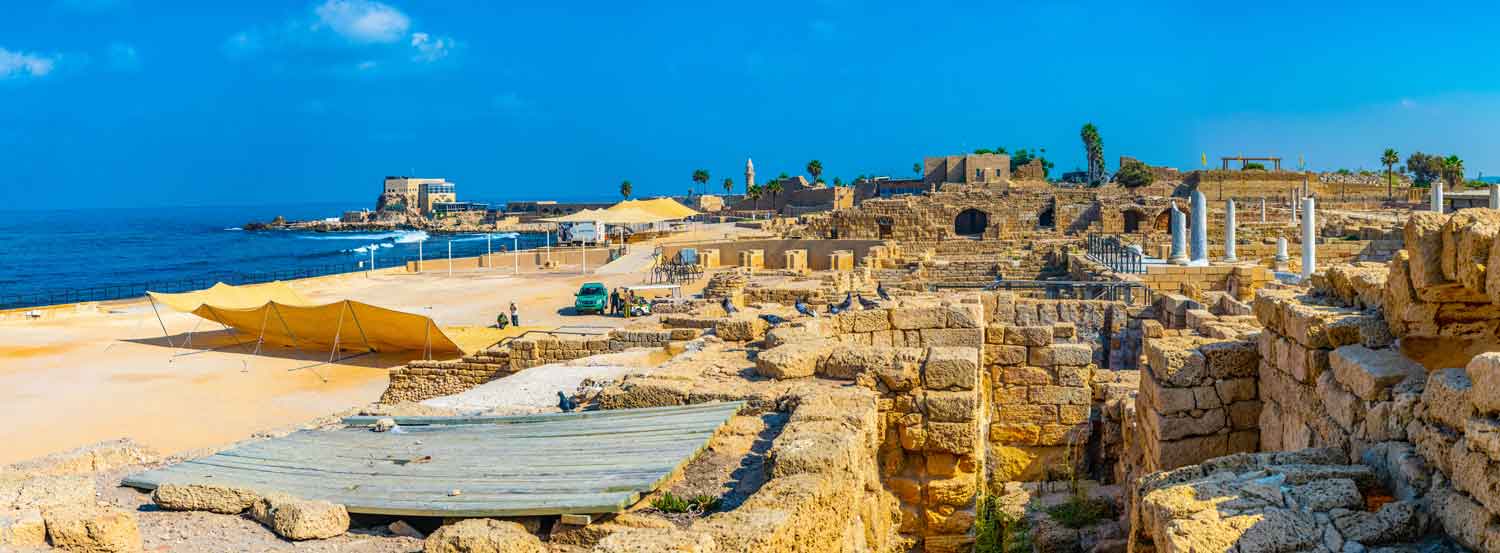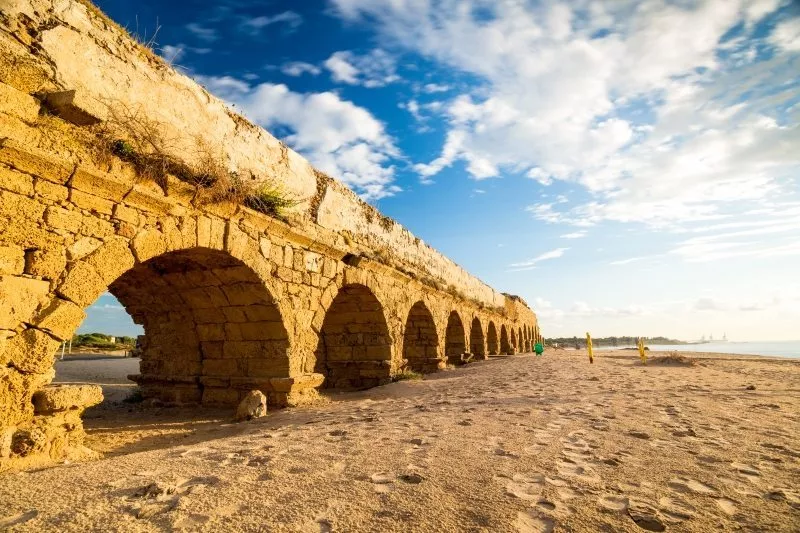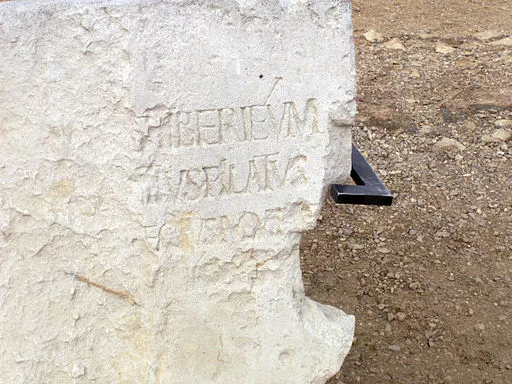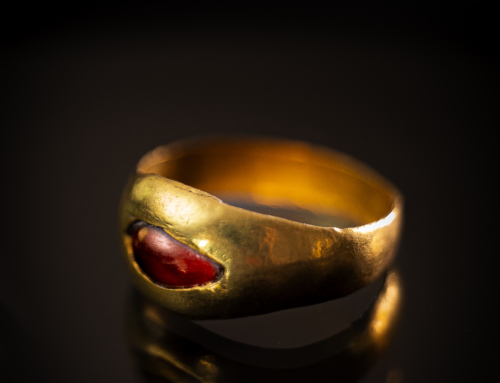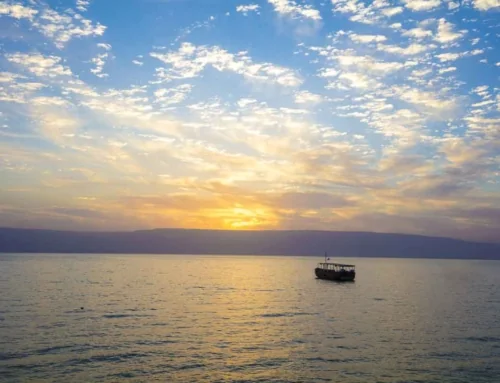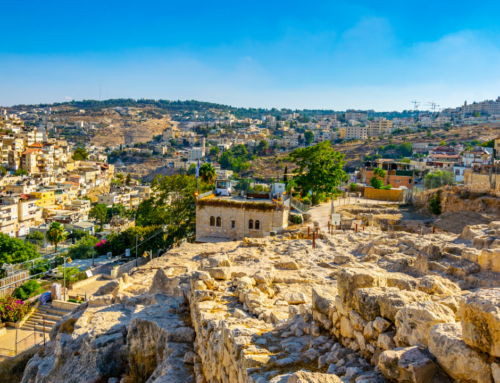A frequent exciting first stop on many of the HOLY LAND TOURS we operate is Caesarea Maritima, along the shores of the Mediterranean Sea. This ancient port city continues to give revelations about ancient Israel for both visitors and researchers. For many people, it becomes one of the highlights of their trip. What makes these ancient ruins so special?
How Long Has Caesarea Maritima Been There?
The earliest known inhabitation of the area was by Straton I, King of Sidon around 360 B.C. as a Phoenician colony and trading center. It was captured by Jewish ruler Alexander Jannaeus in 90 B.C. The Romans took over the area in 63BC. In 30BC Rome awarded the area to Herod the Great.
Caesarea Maritima under Herod the Great
Herod was known as “The Great” because he was a great builder. Caesarea Maritima was no exception. The area had been known as Straton’s Tower, but Herod changed it to Caesarea Maritima in honor of Caesar Augustus. Herod built what had been a minor trading area into a busy and bustling port city. The area was complete with a harbor, markets, store rooms, roads, baths, temples and public buildings, an amphitheater and a personal palace. It was an impressive city.
In addition to the above listed building achievements, a Roman aqueduct also was built to bring fresh water to the Coastal city. Remains of the structures still stand today, two-thousand years later.
In 6AD Rome made it the center of the military presence instead of Jerusalem. Roman governors of Judea lived their and only traveled to Jerusalem as needed. This would have included Pontious Pilate, the Roman Governor who sentenced Jesus to death on the cross.
Caesarea Maritima and the Early Christian Church
Caesarea Maritima had a huge part in the early Christian church and was considered a main hub. Phillip the Deacon was the one who brought the gospel to the city. The Apostle Paul spent a lot of time in the area, including being imprisoned there for two years. Many events of the book of Acts took place in the harbor city, including one of the most important actions of the early church, the grafting in of the Gentiles with the first Gentile being baptized by Peter, Cornelius the Centurion.
Origen, an early Christian Scholar in the third century, compiled the Hexapla there. It was a complex Greek translation of the Old Testament. Eusabius, of the same time period, was the first major church historian and also lived in Caesarea.
The End of Caesarea Maritima
The city went through changes of power over the centuries until it finally was completely destroyed in 1265 AD after the Mamluks completely destroyed the city which was at the time controlled by the Crusaders. They did this to make sure that it did have any hope of reforming and becoming a stronghold of the Crusaders again.
Caesarea Maritima Today
The city sat in ruins for hundreds of years with only a few fishing families inhabiting the area. in the 1950’s large scale archeological excavations began and have continued for nearly 70 years with constant discoveries being made. It was made into a national park in 2011.
Archeological Finds
The Caesarea Maritima park has been an active archeological site over seven decades. It has given tremendous insight into life at the time, including to help validate the Bible.
Today when you visit, you can still sit in the amphitheater, visit the hippodrome and walk on the very stones that the heroes of the faith once may have very well walked. You can walk the grounds and see the dilapidated remains of the harbor that has long since began falling into the ocean Now, there are frequent fishermen there. The aqueduct still stands and various Roman columns and arches remain to walk through.
Items such as jewelry and household items have been found in the area as it has been inhabited for thousands of years by at least a few families.
An important finding there was was the “Pilate Stone” which is the only contemporary proof of Pontious Pilate outside of the New Testament. Since the seat of the Roman government was in Maritima and not in Jerusalem, it is likely that is there he made his home and he only traveled to Jerusalem when needed, like for the biggest congregation of Jews every year, Passover.
One ruin is believed to have been the prison, based on an inscription found in rubble. This would then have been where Paul was imprisoned for two years.
Mosaics continue to be found at the site. Some depict animals and are from the Roman period and are believed to be where a palace was located.
Some discoveries have taken place not by people digging, but by diving. Shipwrecks and treasures have been found under water where the harbor was located.
In 2019, an 80 million-shekel visitor’s center was opened, using the ruins of the pagan temple as it’s footings. Within it, you can explore the history of the area and learn in depth about what different ruins were. This is a wonderful addition to the park, which is the most visited in all of Israel.
Now is the time to plan your CHRISTIAN HOLY LAND TOUR. Our Tour Operators would love to prepare an itinerary for you that includes Casearea Maritima in it!

